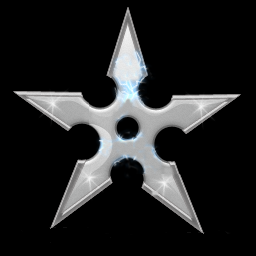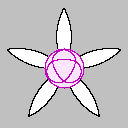Shurikens
The formation of
full shurikens,
half shurikens,
stretched full shurikens, and
stretched half shurikens,
are diifferent ways of constructing maps (generally not regular
maps), in non-orientable surfaces, from known regular maps. They
all involve the insertion of crosscaps, so the resulting maps
are necessarily in non-orientable surfaces.
If a regular map is described by
Sn: {p,q} V F E
(meaning, it is in the orientable manifold of genus n, each face has
p edges, each vertex has q edges, and it has V vertices, F faces and E edges),
or by
C2n: {p,q} V F E
(similar, but in the non-orientable manifold of genus 2n)
then its full shuriken is described by
C(V+2n): {2p,4} E F 2E
(meaning, it is in the non-orientable manifold of genus V+2n, each face
has 2p edges, each vertex has 4 edges, and it has E vertices, F faces and 2E edges).

To convert a regular map to its full shuriken,
- replace each vertex by a crosscap
- replace each edge by a 4-valent vertex (as shown to the right)
- each face becomes a new face with twice as many edges
The full shuriken will probably not be regular. If p,
the number of edges per face, was even, the full shuriken will have some digonal
faces, and will definitely not be regular.
Example

 An example of a full shuriken which is a regular map is shown here. We start with the
tetrahedron (left), and get
C4:{6,4}3 (right).
An example of a full shuriken which is a regular map is shown here. We start with the
tetrahedron (left), and get
C4:{6,4}3 (right).
If a regular map has a bipartite graph (i.e. its vertices can be partitioned
into two sets such that each edge joins a vertex from each set), and is described by
Sn: {p,q} 2V F E
(meaning, it is in the orientable manifold of genus n, each face has
p edges, each vertex has q edges, and it has 2V vertices, F faces and E edges),
or by
C2n: {p,q} 2V F E
(similar, but in the non-orientable manifold of genus 2n)
then its half shuriken is described by
C(V+2n): {p,2q} V F E
(meaning, it is in the non-orientable manifold of genus V+2n, each face
has p edges, each vertex has 2q edges, and it has V vertices, F faces and E edges).

To convert a regular map to its half shuriken,
- replace alternate vertices by crosscaps
- double the valency of the remaining vertices, with two edges connecting
them to each crosscap (as shown to the right)
- each face continues to be a face with the same number of edges
The half shuriken will probably not be regular.

 An example of a half shuriken which is a regular map is shown here. We start with the
cube (left), and get
C4:{4,6}3 (right).
An example of a half shuriken which is a regular map is shown here. We start with the
cube (left), and get
C4:{4,6}3 (right).
If a regular map is described by
Sn: {p,q} V F E
(meaning, it is in the orientable manifold of genus n, each face has
p edges, each vertex has q edges, and it has V vertices, F faces and E edges),
or by
C2n: {p,q} V F E
(similar, but in the non-orientable manifold of genus 2n)
then its stretched full shuriken is described by
C(V+2n): {2p,4} E F 2E
(meaning, it is in the non-orientable manifold of genus V+2n, each face
has 3p edges, each vertex has 3 edges, and it has 2E vertices, F faces and 3E edges).

To convert a regular map to its full shuriken,
- replace each vertex by a crosscap
- replace each edge by two 3-valent vertices (as shown to the right)
- each face becomes a new face with three times as many edges
The stretched full shuriken will not be regular. If q,
the number of edges per vertex, was even, the full shuriken will have some digonal
faces.
Relationship to Truncated Regular Maps
The stretched full shurikens which I have looked at are Petrie duals
of truncated regular maps
(which are never themselves regular).
The stretched full shuriken of the hemicube is the Petrie dual of the truncated tetrahedron,
the stretched full shuriken of the tetrahedron is the Petrie dual of the truncated hemicube,
the stretched full shuriken of the cube is the Petrie dual of the truncated {6,3}(2,2), and
the stretched full shuriken of {6,3}(2,2) is the Petrie dual of the truncated cube.
If a regular map has three edges meeting at each vertex, and has a bipartite graph
(i.e.its vertices can be partitioned into two sets such that each edge joins
a vertex from each set), and is described by
Sn: {p,3} 2V F E
(meaning, it is in the orientable manifold of genus n, each face has
p edges, each vertex has q edges, and it has 2V vertices, F faces and E edges),
or by
C2n: {p,q} 2V F E
(similar, but in the non-orientable manifold of genus 2n)
then its half shuriken is described by
C(V+n): {2p,3} E+V/2 F 6V
(meaning, it is in the non-orientable manifold of genus V+2n, each face
has 2p edges, each vertex has 3 edges, and it has E+V/2 vertices, F faces and 6V edges).

To convert a regular map to its stretched half shuriken,
- replace alternate vertices by crosscaps
- retain the remaining vertices as vertices
- replace each edge by new vertex, with one edge connecting it to an old
vertex and two connecting it to a new crosscap (as shown to the right)
- each face continues to be a face but with twice as many edges
The stretched half shuriken will not be regular.
Relationship to Alternately-Truncated Regular Maps
The stretched half shurikens which I have looked at are Petrie duals
of alternately truncated
regular maps — regular maps which have had half their vertices truncated. These are
never themselves regular.
The stretched half shuriken of the cube is the Petrie dual of the alternately truncated cube, and
the stretched half shuriken of {6,3}(2,2) is the
Petrie dual of the alternately truncated {6,3}(2,2).
The name "Shuriken"

 A shuriken (strictly, a hira-shuriken)
is a Japanese throwing star, as supposedly used by ninjas. I call structures like the one
shown to the right shurikens, from their resemblance. Unfortunately real shurikens generally
had an even number of blades, while the ones useful in generating regular maps have an odd
number.
A shuriken (strictly, a hira-shuriken)
is a Japanese throwing star, as supposedly used by ninjas. I call structures like the one
shown to the right shurikens, from their resemblance. Unfortunately real shurikens generally
had an even number of blades, while the ones useful in generating regular maps have an odd
number.
Other relationships between regular maps
General Index

 An example of a full shuriken which is a regular map is shown here. We start with the
tetrahedron (left), and get
C4:{6,4}3 (right).
An example of a full shuriken which is a regular map is shown here. We start with the
tetrahedron (left), and get
C4:{6,4}3 (right).

 An example of a full shuriken which is a regular map is shown here. We start with the
tetrahedron (left), and get
C4:{6,4}3 (right).
An example of a full shuriken which is a regular map is shown here. We start with the
tetrahedron (left), and get
C4:{6,4}3 (right).

 An example of a half shuriken which is a regular map is shown here. We start with the
cube (left), and get
C4:{4,6}3 (right).
An example of a half shuriken which is a regular map is shown here. We start with the
cube (left), and get
C4:{4,6}3 (right).

 A shuriken (strictly, a hira-shuriken)
is a Japanese throwing star, as supposedly used by ninjas. I call structures like the one
shown to the right shurikens, from their resemblance. Unfortunately real shurikens generally
had an even number of blades, while the ones useful in generating regular maps have an odd
number.
A shuriken (strictly, a hira-shuriken)
is a Japanese throwing star, as supposedly used by ninjas. I call structures like the one
shown to the right shurikens, from their resemblance. Unfortunately real shurikens generally
had an even number of blades, while the ones useful in generating regular maps have an odd
number.